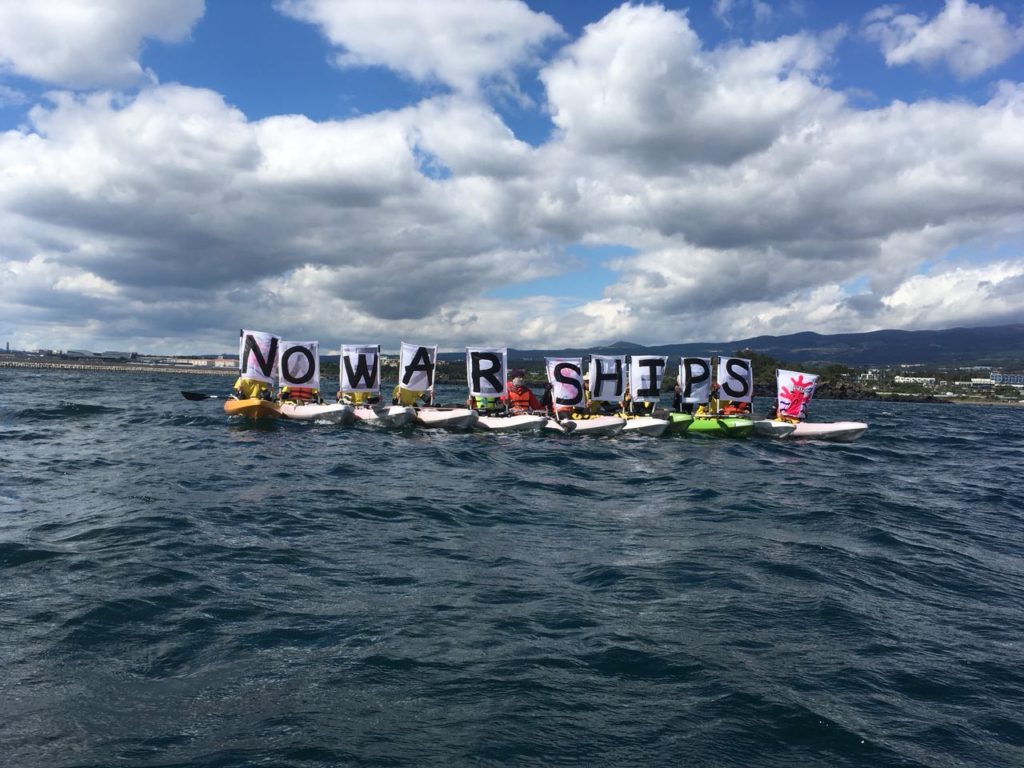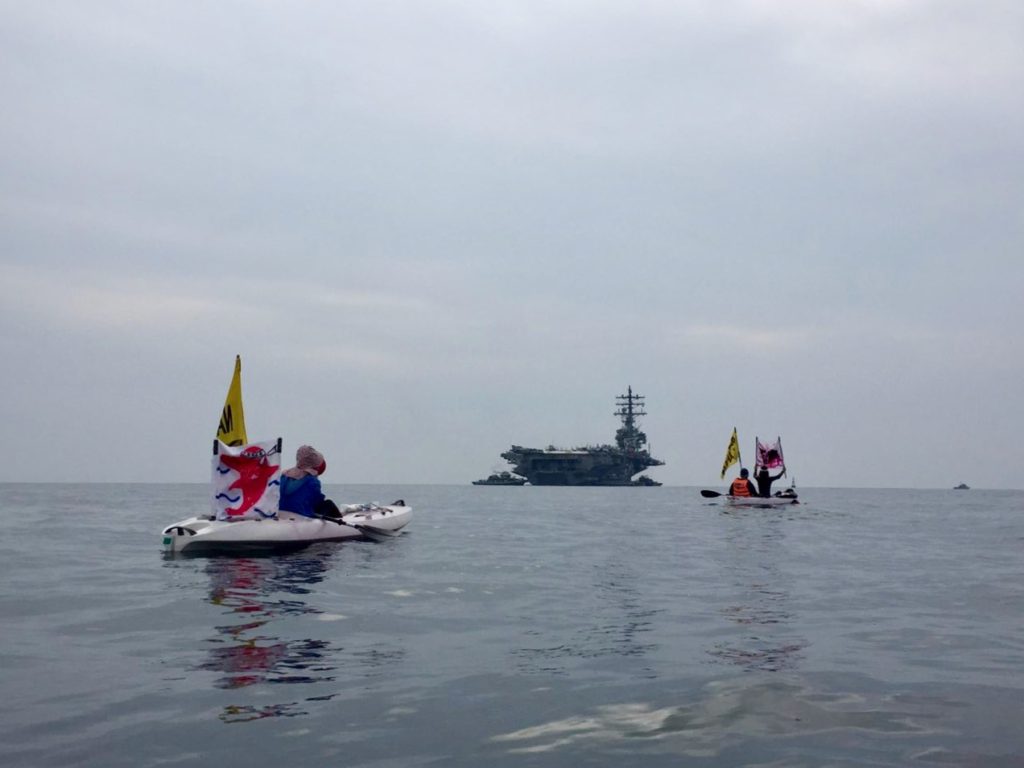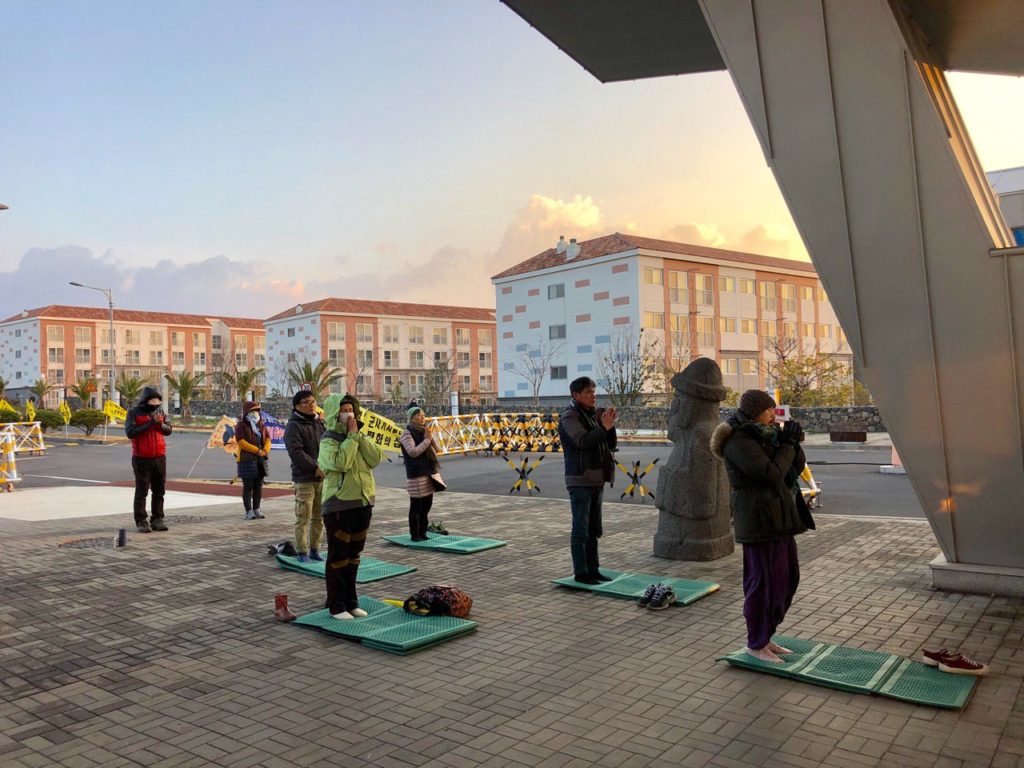Kaia Vereide: Activism Beyond Bases and Borders
Written by Gianna Francesca Catolico
Every year, thousands of travelers and so-called ‘honeymooners’ are drawn to the pristine island of Jeju. Yet Jeju’s touristic bravado has been periled by three controversial issues confronting Jeju today: the existence of the Jeju Civilian-Military Complex Port, the unforeseen arrival of Yemeni refugees, and the mapping out of a second international airport in the area.
Among the locals standing up against displacement and environmental destruction, a young foreign activist is making waves with her peace activism. Kaia Vereide, an American, has been at the forefront in campaigning against the construction and operation of her country’s military bases in Asia, chiefly in Jeju.
At 31 years of age, Kaia’s blazing experience for human rights and peace activism became entrenched in her college years. Born and raised in Maryland and taking up international relations and French language at the American University in Washington, Kaia volunteered for faith-based groups before voyaging into the Land of the Morning Calm.

The Gwangju News sat down with Kaia for a brief conversation about the human rights situation in Jeju.
Gwangju News (GN): When did you move to Korea? When did you first learn about human rights and peace issues in the Korean peninsula?
Kaia: While studying, I was looking for volunteering opportunities, and I found Jubilee Partners, a religious organization that works for refugees near Atlanta. It made me want to do more in peace organizations, so I went back to Jubilee after graduation. I was mainly welcoming refugees from Myanmar. Moreover, my five-month study in France made me more curious and interested in living overseas. I made multiple connections from Korea in my university. I came to Korea in March 2013 with the Northeast Asia Regional Peacebuilding Institute (NARPI).
Then, I moved to Jeju in 2016. I read the book by Bruce Cumings about the Korean War, so I was familiar with the Jeju Uprising. Rather than listening to the people of Jeju, the government listened only to the U.S. military. The people who experienced the Jeju Uprising have trauma left from that tragedy, which is one reason to oppose the building of the naval base.
GN: What motivated or inspired you to become a peace activist in Korea?
Kaia: I have been interested in learning about human rights. When I learned about the Darfur genocide in Sudan during high school, I became more interested in international issues. When I came to Korea, I worked for two years with NARPI, then two years with the Frontiers. I left the Frontiers in December 2018, and I currently work with St. Francis Peace Center. I am helping with peace education and international solidarity, sharing the news of the locals, and trying to stop negative influences from outside.
GN: What are the environmental impacts of the Jeju Civilian-Military Complex Port? How did this facility affect the livelihood of locals living nearby?
Kaia: Gureombi Rock (구럼비 바위) is a 1.2 kilometer-long rock that the Jeju Naval Base was built on top of. The rock itself was used by the locals for fishing, swimming, relaxing, or hiking. The trail and the coast were famous. There was fresh water coming from the rock that locals believe had healing properties, so it’s a sacred place for them. But the government blasted the rock and covered it in concrete, destroying the habitat of the endangered animals living there. Many soft corals died because the breakwater at the navy base blocks the flow of oxygen. The ocean from Seogwipo to Gangjeong is the world’s largest soft coral habitat.

Gureombi rock was supposed to be an absolute preservation area (절대보전지역), but the government canceled the absolute preservation of the area in order to build the naval base. The tangerine orchards near the coast were also destroyed to construct the base. I know some farmers who protested because they lost their orchards.
GN: Do you think that the construction of the Jeju Civilian-Military Complex Port was because of the activities of the Chinese navy along Tsushima strait? Why or why not?
Kaia: Some fishermen who support the Jeju Naval Base have said that they saw Chinese fishing boats. Hence, they felt safer because of the existence of the base. But I think the coast guard is enough to deal with the Chinese fishermen. It’s true that China is increasing its military ships, but the U.S. has also increased its military presence all around China. If the U.S. wants to be respected, it should use negotiations and not military escalation. I think that is a more effective solution.
GN: What are your organization’s programs or campaigns for fighting the presence of American bases in Jeju? Is this situation similar to that of the Okinawa base?
Kaia: The Jeju Naval Base is like other Korean bases: U.S. ships can visit there anytime. In 2017, the U.S. sent seven warships, and in 2018, there was a fleet review where countries sent their warships and used the opportunity to sell their products. Jeju is faced with a huge trash problem, not just from the tourists but now also from the naval ships. I work to oppose the visits by foreign warships to the naval base.
We share the opposition of the locals with the government, but they ignore us. Similarly, Okinawa is discriminated against by mainland Japan. Anti-base activists there have been struggling for 70 years. The Korean government also likes to cover up the news, trying to make people think that there is no more opposition to the navy base, that all issues are finished.

GN: How should the Jeju local government deal with the influx of refugees from Yemen? Do you support Korea’s cancelation of its visa-free policy?
Kaia: I was involved with Hope School, which organized programs with Yemeni refugees. We shared personal experiences such as cultural exchange between Koreans and Yemenis. We shared our understanding on work expectations. So far, the Korean government has handed refugee status to only one or two people while others have been granted humanitarian visas. The visa-free policy is supposed to bring more tourists, but the reception of refugees is a bigger issue. The Korean government needs to expand its infrastructure, understanding, and overall awareness about refugees.
GN: How do you rate the current efforts of the Korean government in providing humanitarian assistance, employment, or granting refugee status to the Yemeni refugees?
Kaia: The sudden arrival of hundreds of Yemeni refugees in Jeju exposed the lack of preparedness of Korea to live up to its ratification of the U.N. Refugee Convention. This seems to include both a lack of resources dedicated to processing refugee or humanitarian status applications and a relative lack of understanding about refugees and Islam. This was made clear by the reaction of many Koreans against the Yemenis who arrived in Jeju last year.

GN: What are your daily activities in Jeju?
Kaia: From Monday to Saturday, I join the 100 Bows for Life and Peace at 7 a.m. outside the naval base. It is a good way to start the day with some exercise, prayer, meditation, and talk with the friends who join. It creates a space and a presence for peace that weakens the power of militarism in subtle symbolic ways. Although I am not Catholic, I sometimes join the Street Mass that is held at 11 am in a tent across the street from the old construction entrance to the base.

Everyday at 12 noon in front of the Jeju Navy Base there is a human chain protest with signing and dancing. (Photo by Pang Eun Mi.)
At 12 noon, we form a human chain. In the human chain, everyone is welcome to share songs, poems, and short speeches, and then we dance in the street in front of the base. The experience is a good way for visitors to practice stepping out of their comfort zones, and it is a good exercise and community-building activity for us regulars. After the human chain, everyone joins a community meal at Halmangmul (할망물, also called Samgeori 삼거리) Community Kitchen. Like the sharing of rice in the Gwangju Uprising, this meal is the heart of the peace movement in Gangjeong. People from all over Korea donate food, and “Uncle Jonghwan” has been cooking community meals since the beginning of the struggle against the naval base. This is an important space to meet, share ideas, and support one another.
These are the constant parts of my schedule. Other time is spent writing, editing or translating articles, sharing about Gangjeong on social media, attending meetings, gardening, giving tours to visitors, organizing or attending educational and solidarity events, cooking, drinking coffee, reading, hiking, etc. And now and then, we also have kayak protests.

GN: Any message to our readers?
Kaia: I didn’t mention yet about the new plans for a second airport in Jeju. It is like the Jeju naval base issue all over again. The local people who are most affected are opposed, the environmental destruction is being ignored by the government, and it will even be used by the military as well. Jeju is supposed to be the “Island of World Peace,” but it will take a huge effort to stop the militarization and over-development of Jeju, and save the pristine environment for future generations.
I may have a pretty different set of experiences compared to what is “normal,” but my path has been small gradual steps following and joining along with people who have modeled dedication to peace, justice, love, and community. Maybe I’ll see you on the journey. Don’t forget to check out savejejunow.org and “No Naval Base on Jeju” on Facebook.
Photographs courtesy of Kaia Vereide, Pang Eun Mi, Hantol, and Lee Ki Cheol.
The Author
Gianna Francesca Catolico is an intern at the May 18 Memorial Foundation from the Philippines. She recently finished her Masters in Human Rights and Democratization from Mahidol University in Thailand. She has been sojourning around Asia over the past three years.





